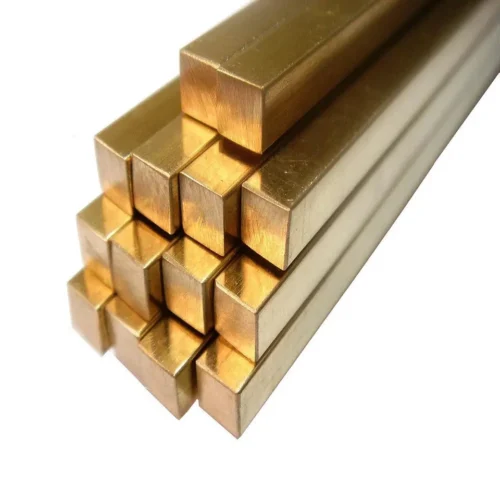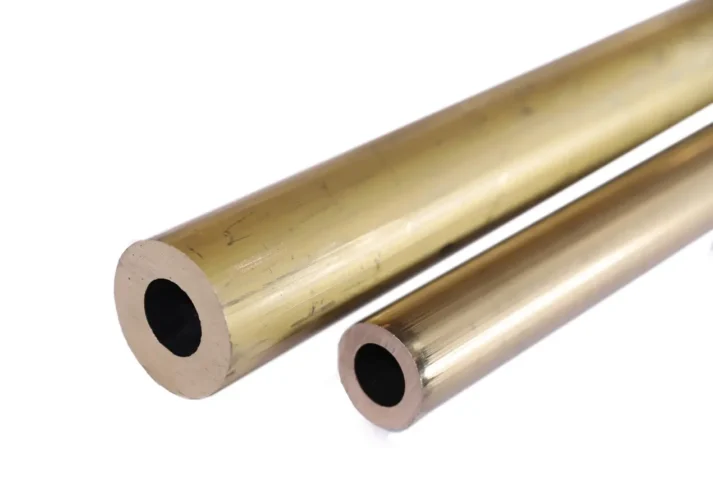Our Location
Aluminum bronze is a type of metal that usually contains less than 11.5% aluminum, but sometimes other elements such as iron, nickel, and manganese are added to enhance its performance. Heat treatment can strengthen this material, resulting in higher durability than tin bronze and better resistance against high-temperature oxidation.
Its high strength and excellent wear resistance make it ideal for use in high-strength screws, nuts, copper sleeves, sealing rings, and other wear-resistant components. The most notable feature of aluminum bronze is its exceptional wear resistance.
Aluminum bronze has even higher strength and wear resistance if it contains iron and manganese. After quenching and tempering, its hardness increases, and it becomes more resistant to high-temperature corrosion and oxidation. It is also corrosion-resistant in the atmosphere, freshwater, and seawater, easy to machine, and can be welded (but not brazed) without any issues. It performs well under hot-pressure processing as well.

Table of Contents
ToggleAluminium bronze is an alloy primarily made of copper and contains between 4 to 14% aluminum. It may also contain small amounts of other elements such as iron, nickel, or manganese. The presence of aluminum strengthens the copper matrix and improves its resistance to corrosion by forming an aluminum oxide layer on the surface. The addition of iron and nickel further reinforces the strength of aluminum bronze and provides more corrosion resistance. Aluminum bronzes that contain higher amounts of aluminum can match the strength of medium-carbon steel while being more corrosion-resistant.
In the mid-1800s, metallurgists started to experiment with combining copper and aluminum. However, the high cost of production hindered their efforts. In 1913, Durville improved the tilting ladle method to produce aluminum bronze billets by addressing problems related to oxide inclusion and shrinkage. Later, Charles H. Meigh collaborated with the French Admiralty to create nickel-aluminum bronze by enhancing this technique. Despite the attractive features of aluminum bronze, its commercial expansion was initially impeded due to user resistance and casting difficulties. However, after World War II, the expanding offshore oil sector, the growing need for propellers in larger and faster ships, and the necessity for a robust, corrosion-resistant alloy in submarine construction led to the widespread use of aluminum bronze.
Aluminium bronze material is an alloy primarily made of copper, but varying amounts of aluminum, nickel, iron, silicon, and manganese were added as additional elements.
| Aluminum Bronze Alloy Type | Composition Percentage |
| 64200 Aluminum Silicone Bronze | Cu 91.2%, Al 7.0% |
| C63200 Aluminum Bronze | Cu 82%, Fe 4%, Al 9%, Ni 5% |
| C63000 Aluminum Bronze | Cu 82%, Al 10%, Ni 5%, Fe 3% |
| C62300 Aluminum Bronze | Cu 82.2%-89.5%, Al 8.5%-11.0%, Fe 2.0%-4.0%, Mn – <=0.6%, Sn – <=0.5%, Si – <=0.25%, Remain – <=0.5% |
You need a clean and well-ventilated area with a crucible or forge to create aluminium bronze. It is essential to wear safety gear and warn people to keep away to ensure your safety. Before melting aluminum and copper, they should be weighed in a 9:1 ratio and placed in an industrial-grade crucible. Melt the metals at 1,038 °C and stir them well using a graphite rod until fully combined. For small-scale forging, you can use a blowtorch. After pouring the molten mixture into a mold, let it sit for 20 minutes until it becomes firm. Then, remove the cooled bronze with caution. To obtain a shiny aluminum bronze product, the classic bronze casting process must be finished by quenching it in water.
Some characteristics of aluminum bronze include:
Aluminum bronze comes in shiny, golden, silvery, and rose-tinted shades. Its color depends on the metal cooling during casting and the age of the alloy. As it ages, the color darkens. Aluminum bronze is aesthetically pleasing, with warm, coppery shades and a golden reflectiveness when polished.

There are different types of aluminum bronzes listed below:
These alloys contain 8-11% aluminum and are often combined with iron or nickel. They provide enhanced strength and are ideal for hot casting. Alloys with 10% or more aluminum are suitable for specialized applications that require high strength, hardness, and wear resistance. Iron improves tensile strength, while nickel enhances corrosion resistance.
This American grade of aluminum bronze contains nickel, iron, and aluminum. It is known for its hardness, corrosion resistance, and high strength.
This variant contains less than 8% aluminum and has lower strength. It is ideal for die casting due to its lower melting point, which enhances energy efficiency. Its non-sparking properties and ease of die-cast tool production make it valuable in the tooling industry. It is ideal for cold working and maintains ductility in hot and cold conditions.
This type of bronze has high mechanical properties, anti-corrosive abilities, and good fatigue. It is similar to aluminum bronze alloys and comprises aluminum, copper, and silicon.
These alloys (8-9% aluminum, 13% manganese) were developed for propeller manufacture. They offer good castability, resistance to impingement and cavitation, and low magnetic permeability post-heat treatment.
This copper-tin alloy is known for its strength, corrosion resistance, and protection against wear.

aluminum bronze tube
| Properties | Characterization |
| Surface | It is known for its unique golden hue that adds an attractive touch to various applications. |
| Corrosion Resistance | It is corrosion-resistant in various environments, especially in seawater and acidic conditions. |
| Strength | It has a high tensile strength when compared to low-alloy steel. |
| Antimicrobial | Some aluminum bronzes may be biocompatible, making them suitable for certain medical applications such as dental alloys. |
| Machinability | Due to its high strength, abrasiveness, thermal conductivity, copper content, and poor chip formation, it can be challenging to machine. It can affect the durability of tools used for machining. |
| Weldability | It usually does not require preheating except for thick sections. Thorough cleaning before and after each pass is recommended to prevent porosity. These alloys are helpful as weld-depositing surfacing materials for wear, corrosion, and sparking resistance. |
| Properties | Characterization |
| Corrosion Resistance | The material’s resistance to corrosion is due to the formation of a tough, thin layer of alumina (aluminum oxide) that acts as a barrier to corrosion. |
| Oxidation Resistance | This material can withstand high temperatures without experiencing significant oxidation. |
| Composition | The material contains copper and aluminum in the 4-14% percentage range, and the rest is made up of small amounts of nickel, iron, manganese, zinc, and silicon. |
| Physical Property | Value |
| Melting Point (°C) | 1030 |
| Young’s Modulus(GPa) | 110 |
| Density(g/cm³ at 20 °C) | 7.45 |
| Ultimate Tensile Strength(Mpa) | 550-900 |
| Thermal Conductivity(W/mK) | 59 |
| Brinell Hardness( BHN) | 170-177 |
Aluminum bronze is a copper alloy with a wide range of applications due to its combination of properties. Some of its uses include:
1. Aircraft & Aerospace components for strength, corrosion resistance, and heat stability.
2. Guitar strings for bright tones and corrosion resistance.
3. Engine components for strength, wear resistance, and heat dissipation.
4. Chemical processing equipment that handles nonoxidizing acids due to its corrosion resistance.
5. Actuated Butterfly Valves for corrosive conditions.
6. Industrial process fluids handling equipment due to its resistance to corrosion from many industrial fluids.
7. Marine hardware for durability and corrosion resistance.
Aluminum bronze is a dependable material that offers prolonged equipment life, reliability, and efficiency in various applications.
Advantages of aluminum bronze:
– Easy to weld
– Available in wrought or cast forms
– Exceptional hardness and compressive strength
– Low friction coefficient
– Ideal for hazardous environments
– Durable against wear and abrasion
Disadvantages of aluminum bronze:
– Hardness introduces machining challenges
– Requires specific maintenance for appearance
– Limited availability compared to other bronze types
– More expensive than brass due to alloy composition
Aluminum bronze can be welded with MIG welding using an aluminum bronze core wire and pure argon gas. It ensures a strong bond and maintains the alloy’s high-strength properties.
Laser cutting is an effective method for cutting aluminum bronze. Applying an anti-reflective coating is advisable, especially for metals that reflect light. While CO2 lasers can be used, fiber lasers generally produce better results. The process is highly precise, with minimal material loss and reduced thermal stress, which results in a clean and efficient cut.
Aluminum bronze is often used in sand blasting for its strength and corrosion resistance, making it ideal for durable castings.
Aluminum bronze does not rust. It may corrode but does not experience rusting as iron does.
Aluminum bronze can be as strong as low-alloy or certain stainless steels, depending on its composition and heat treatment. However, high-alloy and tool steels generally have greater strength than aluminum bronze.
Aluminum bronze is better than traditional bronze as it has enhanced mechanical properties, including higher yield strength. Aluminum in the alloy contributes to these improved characteristics, allowing heat treatment to achieve the desired properties.
Aluminum bronze doesn’t tarnish. It is highly resistant to tarnishing among copper alloys.
To remove water spots and stains from bronze anodized aluminum, wipe down the affected area with a 2% Citranox solution (20 mL/L or 2.5 oz/gal). For surfaces that require analytical cleanliness, rinse with a separate sponge or wipe using plain water.
Learn about aluminum bronze and its types and applications. Contact Enze for more information. Enze provides manufacturing capabilities and value-added services. Visit our website for a free quote.

